#Java Development Kit (JDK)
Explore tagged Tumblr posts
Text
How can you serialize and deserialize Java objects for frontend-backend communication?

1. What’s Java Serialization and Deserialization All About?
So, how do you handle communication between the frontend and backend in Java? It’s all about turning Java objects into a byte stream (that’s serialization) and then back into objects (deserialization). This makes it easy to exchange data between different parts of your app. The Serializable interface in Java is key for this, as it helps keep the state of objects intact. If you’re taking a Java course in Coimbatore, you’ll get to work on this a lot. Serialization is super important for things like APIs and managing sessions. For Java backend developers, it's a must-know.
2. Why Is Serialization Important Nowadays?
When it comes to Java and modern web apps, we often use JSON or XML for serialized data. Libraries like Jackson and Gson make it easy to convert Java objects to JSON and vice versa. These formats are great for frontend and make communication smoother. If you study Java in Coimbatore, you'll learn how serialization fits into REST APIs. Good serialization helps keep your app performing well and your data secure while also supporting setups like microservices.
3. What’s the Serializable Interface?
The Serializable interface is a simple marker in Java telling the system which objects can be serialized. If you get this concept down, it really helps answer how to serialize and deserialize Java objects for frontend-backend communication. By using this interface, you can easily save and send Java objects. Students in a Java Full Stack Developer Course in Coimbatore learn how to manage complex object structures and deal with transient variables to keep things secure and fast.
4. Tools and Libraries for Serialization in Java
To serialize objects well, developers often rely on libraries like Jackson and Gson, along with Java’s ObjectOutputStream. These are essential when you’re trying to serialize Java objects for frontend-backend communication. With these tools, turning Java objects into JSON or XML is a breeze. In Java courses in Coimbatore, learners work with these tools on real projects, and they offer options for customizing how data is serialized and handling errors more smoothly.
5. Deserialization and Keeping Things Secure
Deserialization is about getting objects back from a byte stream, but you've got to do this carefully. To serialize and deserialize Java objects safely, you need to check the source and structure of incoming data. Training in Coimbatore covers secure deserialization practices so you can avoid issues like remote code execution. Sticking to trusted libraries and validating input helps keep your app safe from attacks.
6. Syncing Frontend and Backend
Getting the frontend and backend in sync relies heavily on good serialization methods. For instance, if the Java backend sends data as JSON, the frontend—often built with React or Angular—needs to handle it right. This is a key part of learning how to serialize and deserialize Java objects for frontend-backend communication. In Java Full Stack Developer Courses in Coimbatore, students work on apps that require this skill.
7. Dealing with Complex Objects and Nested Data
A big challenge is when you have to serialize complex or nested objects. When figuring out how to serialize and deserialize Java objects for frontend-backend communication, you need to manage object references and cycles well. Libraries like Jackson can help flatten or deeply serialize data structures. Courses in Coimbatore focus on real-world data models to give you practical experience.
8. Making Serialization Efficient
Efficient serialization cuts down on network delays and boosts app performance. Students in Java training in Coimbatore learn how to make serialization better by skipping unnecessary fields and using binary formats like Protocol Buffers. Balancing speed, readability, and security is the key to good serialization.
9. Real-Life Examples of Java Serialization
Things like login sessions, chat apps, and shopping carts all depend on serialized objects. To really understand how to serialize and deserialize Java objects for frontend-backend communication, you need to know about the real-time data demands. In a Java Full Stack Developer Course in Coimbatore, you’ll get to simulate these kinds of projects for hands-on experience.
10. Wrapping It Up: Getting Good at Serialization
So how should you go about learning how to serialize and deserialize Java objects? The right training, practice, and tools matter. Knowing how to map objects and secure deserialized data is crucial for full-stack devs. If you're keen to master these skills, check out a Java course or a Java Full Stack Developer Course in Coimbatore. With practical training and real projects, Xplore IT Corp can set you on the right path for a career in backend development.
FAQs
1. What’s Java serialization for?
Serialization is for turning objects into a byte stream so they can be stored, shared, or cached.
2. What are the risks with deserialization?
If deserialization is done incorrectly, it can lead to vulnerabilities like remote code execution.
3. Can every Java object be serialized?
Only objects that implement the Serializable interface can be serialized. Certain objects, like threads or sockets, can’t be.
4. Why use JSON for communication between frontend and backend?
JSON is lightweight, easy to read, and can be easily used with JavaScript, making it perfect for web apps.
5. Which course helps with Java serialization skills?
The Java Full Stack Developer Course in Coimbatore at Xplore IT Corp offers great training on serialization and backend integration.
#Java programming#Object-oriented language#Java Virtual Machine (JVM)#Java Development Kit (JDK)#Java Runtime Environment (JRE)#Core Java#Advanced Java#Java frameworks#Spring Boot#Java APIs#Java syntax#Java libraries#Java multithreading#Exception handling in Java#Java for web development#Java IDE (e.g.#Eclipse#IntelliJ)#Java classes and objects
0 notes
Text
#Learn Java#Java course#Java developer#Java script#Java certification#Java ide#Java programming#Java tutor#Jms#Jdk#Java online course#Java development kit#Java developer course#Learn Java programming#Java certification course#Java coding#Java jdk#Learn Java online#Java for beginners
0 notes
Text
incidentally does anyone have experience troubleshooting java installation on mac
#i keep trying to install jdk23 and it just Does Not Stick. according to all the tutorials i could find i'm doing everything right#and the installer seems to work perfectly fine. but then when it's finished and i try to use it i still don't have java#i'm genuinely so deeply confused as to what's going on#java#tech support#jdk#java development kit
1 note
·
View note
Text
A Comprehensive Guide to Java 17 New Features
Java 17, the latest long-term support (LTS) release, has arrived with a plethora of exciting new features and enhancements. In this blog post, we’ll take an in-depth look at all the noteworthy additions to the Java ecosystem in this groundbreaking release. 1. Sealed Classes Sealed classes provide a new way to restrict the inheritance hierarchy, allowing developers to define a limited set of…

View On WordPress
1 note
·
View note
Text
My First Java Program: A Journey into Coding

Starting with Java programming can be an exciting journey, filled with discovery, challenges, and a sense of accomplishment. My experience of writing my first Java program was a significant milestone that opened up a world of possibilities in software development. In this blog, I’ll share my journey through writing my first Java program, along with the concepts I learned and the obstacles I overcame.
The Excitement of Starting
When I first decided to learn Java, I was motivated by its versatility and widespread use in developing applications, from mobile apps to enterprise software. I had heard about the power of Java and how it is a foundational language for many developers. After setting up my Java development environment, which included installing the Java Development Kit (JDK) and choosing an Integrated Development Environment (IDE) like Eclipse, I was ready to dive in.
The anticipation of writing my first program filled me with excitement. I had heard many experienced programmers talk about how exhilarating it felt to see their code come to life, and I was eager to experience that feeling myself.
Setting Up the Development Environment
Before I could write my first program, I needed to ensure my development environment was properly configured. Here’s a brief overview of how I set it up:
1. Installing the JDK: I downloaded the latest version of the Java Development Kit from the Oracle website. This included everything I needed to compile and run Java applications.
2. Choosing an IDE: I chose Eclipse as my IDE because of its robust features and user-friendly interface. After downloading and installing it, I was ready to start coding.
3. Verifying the Installation: I opened the command prompt (or terminal) and typed java -version to confirm that Java was installed correctly. Seeing the version number displayed confirmed that I was on the right track.
Writing My First Java Program
With my development environment set up, I was finally ready to write my first Java program. Following the traditional approach, I decided to create a simple “Hello, World!” program. This classic exercise is often the first step for beginners learning any programming language.
Step 1: Creating a New Java Project
In Eclipse, I created a new Java project:
1. File > New > Java Project.
2. I named the project “HelloWorld” and clicked Finish.
Step 2: Creating a New Java Class
Next, I created a new Java class within the project:
1. Right-click on the src folder in the HelloWorld project.
2. Selected New > Class.
3. I named the class HelloWorld and checked the box to include the public static void main(String[] args) method. This method is the entry point of any Java application.
Step 3: Writing the Code
With the class created, I wrote the code that would print “Hello, World!” to the console:
public class HelloWorld { public static void main(String[] args) { System.out.println(“Hello, World!”); } }
Code Explanation
public class HelloWorld: This line defines a public class named HelloWorld. In Java, every application must have at least one class.
public static void main(String[] args): This line declares the main method, which is the starting point of any Java program. The JVM (Java Virtual Machine) looks for this method when executing the program.
System.out.println(“Hello, World!”);: This line prints the string “Hello, World!” to the console. The System.out object is used to output data to the console, and println is a method that prints the text followed by a newline.
Step 4: Running the Program
After writing the code, it was time to run my program and see the result:
1. I right-clicked on the HelloWorld.java file in the Project Explorer.
2. Selected Run As > Java Application.
To my delight, the console displayed the message “Hello, World!” It was a simple program, but seeing the output felt like a monumental achievement. I had successfully written and executed my first Java program!
Learning from the Experience
The process of writing my first Java program taught me several important lessons:
Understanding Java Syntax
Java has a specific syntax that must be followed. This includes rules about naming conventions, the use of semicolons to end statements, and the structure of classes and methods. Understanding these rules is essential for writing valid Java code.
The Importance of the Main Method
The main method is crucial in Java applications. It serves as the entry point, and every program must have it to be executed. Learning this concept helped me appreciate how Java applications are structured.
The Power of Output Statements
Using System.out.println() was my first experience with output statements. It highlighted the importance of feedback in programming. Being able to print messages to the console is invaluable for debugging and understanding program flow.
Overcoming Challenges
While writing my first Java program was largely straightforward, I faced some challenges along the way:
Syntax Errors
Initially, I encountered syntax errors due to missing semicolons or misnamed classes. Each error message provided insight into what I needed to correct. This experience emphasized the importance of careful coding and attention to detail.
Understanding the IDE
Familiarizing myself with Eclipse took some time. I had to learn how to navigate the interface, manage projects, and use features like code suggestions and debugging tools. As I continued coding, I became more comfortable with the IDE.
Next Steps in My Java Journey
Completing my first Java program was just the beginning. With a foundational understanding of Java syntax and structure, I was excited to explore more advanced concepts. Here are the next steps I took in my learning journey:
Exploring Java Basics
I delved deeper into Java basics, including:
Data Types: Understanding primitive and reference data types.
Variables: Learning how to declare and use variables effectively.
Operators: Exploring arithmetic, relational, and logical operators.
Control Flow Statements: Mastering if-else, switch, and loop constructs.
Learning Object-Oriented Programming (OOP)
Java is an object-oriented programming language, and I knew I had to understand OOP principles. I focused on concepts such as:
Classes and Objects: Learning how to create and manipulate objects.
Inheritance: Understanding how classes can inherit properties from other classes.
Encapsulation: Learning how to hide data within classes.
Polymorphism: Exploring method overloading and overriding.
Building Projects
I started working on small projects to apply my knowledge. Simple applications, like a calculator or a text-based game, helped solidify my understanding of Java concepts.
Conclusion
Writing my first Java program was a thrilling experience that marked the beginning of my journey as a programmer. The excitement of seeing my code come to life, coupled with the knowledge I gained, fueled my desire to continue learning and growing in the field of software development.
Java has proven to be a powerful language with endless possibilities, and I am eager to explore its depths further. With each program I write, I feel more confident in my coding abilities and more inspired to tackle new challenges.
If you’re starting your Java journey, embrace the process, celebrate your successes, and don’t shy away from challenges. Each step you take brings you closer to becoming a proficient Java developer.
Happy coding!
2 notes
·
View notes
Text
Mastering Java: Your Comprehensive Guide to Programming Excellence
Embarking on the journey of mastering Java is akin to entering a realm of endless possibilities. Java, a versatile and widely-utilized programming language, offers a broad spectrum of applications, from crafting web and mobile applications to powering robust enterprise systems. Whether you are a novice in the realm of coding or a seasoned programmer looking to broaden your skill set, the path to proficiency in Java is an exciting one.

In this comprehensive guide, we will be your guiding light through the intricacies of Java, starting from the foundational basics and progressing to the more advanced aspects of the language. Our objective is to equip you with the knowledge and skills that form a robust and unshakable foundation for your journey into the vibrant world of Java. Fasten your seatbelt as we embark on this exhilarating exploration, charting a course that will empower you to thrive in the ever-evolving landscape of software development.
Here's a 8-step guide to effectively learn Java
Step 1: Setting Up Your Development Environment
Your journey to becoming a proficient Java developer commences with setting up your development environment. The essential components are the Java Development Kit (JDK) and an Integrated Development Environment (IDE) like Eclipse or IntelliJ IDEA. These tools aren't just convenient; they're the gears that will drive your Java programming endeavors. They streamline the coding process, provide useful features, and offer an organized workspace, making your coding experience efficient and enjoyable.
Step 2: The Foundation - Learning the Basics
With your development environment ready, it's time to delve into the fundamental building blocks of Java. Begin by acquainting yourself with data types, variables, operators, and control structures. These are the nuts and bolts of the language, and a solid grasp of these concepts is essential. You'll find an abundance of online tutorials and beginner-friendly Java books to assist you at this stage.
Step 3: Navigating the World of Object-Oriented Programming (OOP)
The object-oriented programming (OOP) approach is well known in Java. To harness the true power of Java, immerse yourself in the world of OOP. Understand the concepts of classes, objects, inheritance, encapsulation, and polymorphism. This knowledge forms the bedrock of Java programming and enables you to design efficient, organized, and scalable code.
Step 4: Mastering Data Structures and Algorithms
Data structures (such as arrays, lists, and sets) and algorithms are the secret sauce behind solving real-world problems efficiently. As you progress, dive into the world of data structures and algorithms. These are the tools that will empower you to handle complex tasks and optimize your code. They're your go-to assets for creating efficient and responsive applications.
Step 5: The Art of Exception Handling
Java boasts a robust exception-handling mechanism. Understanding how to handle exceptions properly is not just an add-on skill; it's a vital aspect of writing reliable code. Exception handling ensures that your code gracefully manages unexpected situations, preventing crashes and delivering a seamless user experience.
Step 6: Exploring Input and Output Operations
In this step, you'll explore the realm of input and output (I/O) operations. Mastering I/O is crucial for reading and writing files, as well as interacting with users. You'll gain the ability to build applications that can efficiently process data and communicate effectively with users.
Step 7: Conquering Multi tasking
Java's support for multi tasking is a significant advantage. Understanding how to manage threads and synchronize their actions is vital for creating concurrent applications. Multithreading is the key to developing software that can handle multiple tasks simultaneously, making your applications responsive and scalable.
Step 8: Building Projects and Real-World Practice
Theory is only as valuable as its practical application. The final step involves applying what you've learned by building small projects. These projects serve as a proving ground for your skills and provide valuable additions to your portfolio. Whether it's a simple application or a more complex project, the act of building is where the real learning takes place.

As you step into this vibrant realm of Java, remember that continuous learning is the key to staying relevant and effective in the ever-evolving field of software development. Be open to exploring diverse applications, from web development to mobile apps and enterprise solutions, and never underestimate the power of hands-on practice. Building projects, no matter how small, will solidify your knowledge and boost your confidence.
In your quest to master Java, ACTE Technologies stands as a valuable ally. Their expert guidance and comprehensive training programs will sharpen your skills, boost your confidence, and pave the way for a rewarding career in software development. Whether you're embarking on your Java journey or looking to take your skills to the next level, ACTE Technologies offers the resources and support you need to thrive in the world of Java programming.
So, with Java as your trusty companion, and ACTE Technologies as your guide, the possibilities are boundless. Your journey is just beginning, and the world of software development awaits your innovation and expertise. Best of luck on your path to mastering Java!
9 notes
·
View notes
Text
Embarking on the Selenium Learning Journey: A Guide to Web Automation Mastery
Learning Selenium and mastering web automation is an empowering journey that opens doors to diverse opportunities in the realm of software development and testing. Embracing Selenium's capabilities becomes even more accessible and impactful with Selenium Training in Bangalore. This training equips individuals with the skills and knowledge to harness the full potential of Selenium, enabling them to proficiently navigate web automation challenges and contribute effectively to their respective fields. In this comprehensive guide, we will walk you through the essential steps to learn Selenium on your own, from understanding basic programming concepts to building practical projects and engaging with the Selenium community.

Understand Basic Programming:
Before immersing yourself in the world of Selenium, it's crucial to establish a solid foundation in a programming language. Whether it's Java, Python, C#, or Ruby, a strong grasp of programming concepts is essential for crafting effective Selenium scripts. This initial understanding sets the stage for your journey into web automation.
Set Up Your Development Environment:
Creating a conducive development environment is the next pivotal step. Install the necessary tools, including the Java Development Kit (JDK), an Integrated Development Environment (IDE) such as Eclipse or IntelliJ, and the Selenium WebDriver library. A well-configured environment ensures a seamless and efficient Selenium development process.
Explore Selenium WebDriver Basics:
With your environment set up, it's time to delve into the basics of Selenium WebDriver. Begin by learning how to launch web browsers, navigate through web pages, and interact with different elements like buttons and text fields. Hands-on practice is paramount at this stage, allowing you to gain practical experience and build a solid foundation in Selenium.
Master Locators and Synchronization:
A key aspect of Selenium proficiency is mastering the art of locating web elements using various locators such as ID, class name, XPath, and CSS selectors. Additionally, understanding synchronization techniques is crucial for handling dynamic web pages. Implementing waits ensures the reliability of your scripts, especially in scenarios where elements take time to load.
Build Practical Projects and Join Communities:
Apply your growing knowledge by working on practical projects. Start with a sample automation project and gradually introduce complexity to challenge yourself. Simultaneously, join online communities, forums, and groups dedicated to Selenium. Engage with fellow learners, ask questions, and share your experiences. Learning from a community provides valuable insights and support, enhancing your overall Selenium journey.
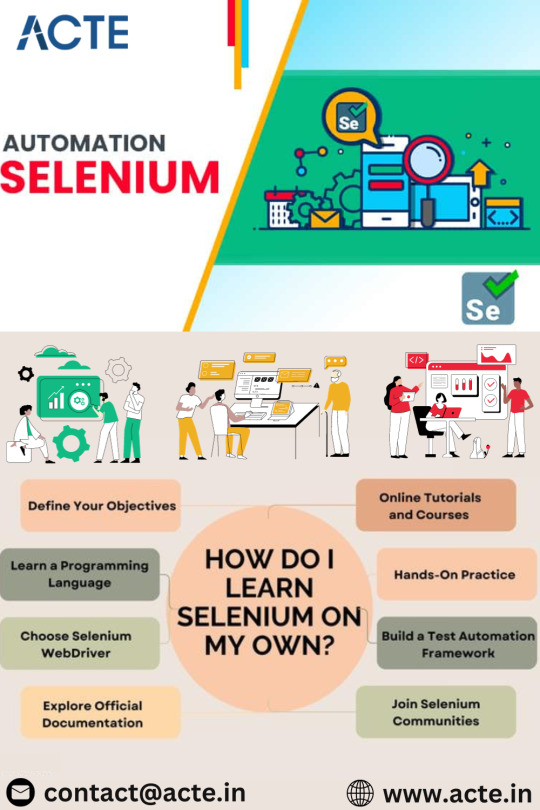
As you navigate the world of Selenium, remember that learning is an iterative process. Consistent practice, exploration of real-world scenarios, and engagement with the Selenium community will solidify your skills and propel you towards web automation mastery. Embark on this journey with enthusiasm, and soon you'll find yourself confidently navigating the exciting landscape of Selenium and web automation. To unlock the full potential of Selenium and master the art of web automation, consider enrolling in the Best Selenium Training Institute. This training ensures that individuals gain comprehensive insights, hands-on experience, and practical skills to excel in the dynamic field of web testing and automation.
2 notes
·
View notes
Text
Navigating the World of Java: From Settings to Mastery
In the dynamic landscape of programming, Java continues to be a powerhouse, driving innovation and development. Let's explore some essential elements—setting up Java, working with command line arguments, and embarking on a Java development course, all within the broader context of technical courses.
Setting Java: Before delving into the exciting world of Java programming, it's crucial to set up your environment correctly. Configuring Java involves a few key steps, ensuring that your development environment is optimized for seamless coding. From installing the Java Development Kit (JDK) to configuring the Java Virtual Machine (JVM), these initial settings lay the foundation for a smooth coding experience.
Command Line Arguments in Java: As you progress in your Java journey, understanding how to work with command line arguments becomes essential. Command line arguments allow for dynamic input, enhancing the versatility of your Java programs. Dive into the intricacies of parsing and utilizing command line arguments to make your Java applications more interactive and user-friendly.
Java Development Course: For those eager to deepen their Java expertise or start their coding journey, a Java development course is an invaluable resource. These courses cover everything from Java syntax and fundamentals to advanced topics like JavaServer Pages (JSP) and Servlets. Whether you're a novice or an experienced coder, a structured Java development course can refine your skills and keep you up-to-date with the latest industry practices.
Technical Courses: Java is just one facet of the expansive world of technical courses. In today's rapidly evolving tech landscape, a broad spectrum of courses awaits enthusiasts and professionals alike. From data science to web development, technical courses offer a pathway to acquire specialized skills and stay ahead in the competitive field of technology.
Embarking on a journey into the realm of Java—from setting up the environment to mastering command line arguments—is a gateway to a world of possibilities. Whether you're honing your Java skills or exploring diverse technical courses, continuous learning is the key to staying relevant and thriving in the ever-changing landscape of technology. Dive in, embrace the challenges, and let your Java odyssey begin!
2 notes
·
View notes
Text
Understand the Oracle Java License Change and Explore Java Free Alternatives
The Oracle Java license change has become a significant concern for developers, organizations, and businesses relying on Java technology. With the transition in licensing terms, many have been left questioning how it affects their projects and budgets. In light of this, the demand for Java free alternatives has risen sharply as companies strive to reduce costs and maintain compliance. This article explores the implications of the Oracle Java license change and highlights viable Java free solutions.
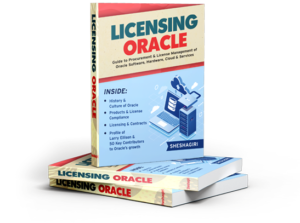
Oracle Java License Change Explained
In 2019, Oracle shifted its licensing model for Java SE (Standard Edition). Before this change, Java was free to download and use for personal and commercial purposes. However, with the new terms, Oracle introduced a subscription-based model, which requires users to pay for commercial use of Java SE.
This change specifically affects the Oracle JDK (Java Development Kit), which had been the go-to distribution for many years. Oracle's move now means that businesses deploying Oracle Java in production environments must purchase a commercial license, incurring annual costs. These costs vary based on the number of users and processors, and for large enterprises, they can become substantial.
Why Did Oracle Change the Java License?
Oracle's rationale for changing the Java license lies in their aim to generate more revenue from a widely used platform. Java is one of the most popular programming languages globally, and Oracle saw an opportunity to monetize its usage more effectively. The subscription model also provides Oracle with a more predictable income stream while encouraging users to adopt newer versions of Java, as support is only offered for the most recent releases.
Despite Oracle's intentions, this change has prompted a major shift in the Java ecosystem. Developers and organizations now face the challenge of reassessing their Java usage and evaluating whether they can continue using Oracle Java or need to explore Java free alternatives.
How the Oracle Java License Change Affects You
If you’re a developer using Java for personal projects or learning purposes, you can still access Oracle Java free of charge. However, for commercial applications, the new license model applies. This means that if your organization uses Oracle Java in production, testing, or development environments, it must pay for a license unless an exemption applies.
Non-compliance can lead to legal and financial risks. Oracle has been known to audit businesses to ensure compliance with their software licensing. Therefore, it is crucial for IT departments and software managers to understand their Java usage and make informed decisions about licensing.
Rise of Java Free Alternatives
Fortunately, Oracle is not the only provider of Java. The open-source nature of Java allows other organizations to build and distribute their own JDKs, which are completely Java free and suitable for commercial use. Here are some of the most popular Java free alternatives:
1. OpenJDK
OpenJDK is the official reference implementation of the Java platform, maintained by the Java community. It is completely open-source and free for commercial and personal use. Many large companies have adopted OpenJDK as their default Java environment.
2. Amazon Corretto
Amazon Corretto is a Java free distribution backed by Amazon. It is based on OpenJDK and is designed for performance and security. Amazon uses Corretto internally, which shows its reliability and stability. Corretto receives regular security updates, making it a solid choice for production environments.
3. Adoptium (formerly AdoptOpenJDK)
Adoptium provides prebuilt binaries of OpenJDK through the Eclipse Foundation. It offers long-term support (LTS) versions and is one of the most popular Java free alternatives. Many companies trust Adoptium for enterprise applications because of its robust support and transparency.
4. Zulu OpenJDK by Azul Systems
Zulu is another reliable Java free distribution built on OpenJDK. It offers certified builds for various platforms and is known for its performance optimizations. Azul also provides enterprise support for organizations requiring assistance.
How to Migrate from Oracle Java
Migrating from Oracle Java to a Java free alternative is a straightforward process, but it requires careful planning. Here are the steps to consider:
Assess Your Java Usage: Determine which applications rely on Oracle Java and whether those environments require a licensed version.
Choose a Compatible JDK: Select a Java free distribution that aligns with your needs. Most alternatives support the same APIs and libraries as Oracle Java.
Test Your Applications: Before switching in production, thoroughly test your applications with the new JDK to ensure compatibility.
Deploy and Monitor: Once testing is successful, deploy the new JDK across your environments and monitor for any issues.
Benefits of Going Java Free
Choosing a Java free alternative offers several advantages:
Cost Savings: Eliminate licensing fees associated with Oracle Java.
Compliance: Avoid legal risks and maintain peace of mind regarding audits.
Flexibility: Select from a variety of JDK distributions that suit your specific needs.
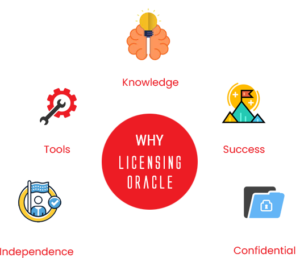
Final Thoughts
The Oracle Java license change has created a shift in how organizations use Java. While it imposes new costs and responsibilities, it also opens the door to exploring robust Java free alternatives that provide similar, if not better, functionality without the licensing burden.
Companies must evaluate their Java usage carefully and take action to avoid unnecessary expenses. By migrating to a Java free solution like OpenJDK, Amazon Corretto, or Adoptium, you can future-proof your applications while staying within budget and maintaining full control of your Java environment.
In today’s evolving tech landscape, understanding the Oracle Java license change and transitioning to a Java free model is not just a cost-saving move—it's a strategic necessity.
0 notes
Text
Top Java Interview Questions and Answers You Must Know in 2025

Preparing for a Java developer role? Whether you're a fresher or an experienced candidate, being well-versed with common Java interview questions can significantly boost your confidence and chances of landing the job.
In this blog, we’ll cover the most frequently asked Java interview questions along with quick answers and explanations.
📘 Looking for a complete, detailed list of Java interview questions? 👉 Check out the full guide here: Java Interview Questions – Freshy Blog
🔹 Why Java?
Before jumping into questions, let’s quickly recall why Java is such a sought-after language:
Platform independent
Strong community support
Object-oriented
Robust memory management
Used in web, mobile, and enterprise apps
🔸 Basic Java Interview Questions
What is Java? Java is a high-level, object-oriented programming language known for its platform independence via the Java Virtual Machine (JVM).
What are the main features of Java?
Object-Oriented
Secure
Portable
Robust
Multithreaded
What is the difference between JDK, JRE, and JVM?
JDK: Development kit for Java
JRE: Environment to run Java applications
JVM: Java Virtual Machine that executes code
🔸 OOPs & Core Concepts Questions
What is inheritance in Java? Inheritance allows one class to acquire properties and methods of another class using extends.
What is the difference between method overloading and overriding?
Overloading: Same method name with different parameters in the same class
Overriding: Same method signature in child and parent class
🔸 Advanced Java Interview Questions
What is a Java ClassLoader? A part of JVM that loads classes during runtime.
What is the difference between HashMap and Hashtable?
HashMap: Non-synchronized, allows one null key
Hashtable: Thread-safe, doesn’t allow null keys/values
Explain exception handling in Java. Using try-catch-finally blocks to gracefully handle run-time errors.
📚 Want More Questions with Answers?
These are just a few of the most asked Java questions. If you're preparing for interviews and want more in-depth explanations and examples:
🔗 Visit the full post here: 👉 https://www.freshyblog.com/java-interview-questions/
It includes:
Java 8 features
Multithreading questions
Collections framework
Spring Boot & JDBC-related questions
Real interview scenarios
✅ Final Tips for Java Interviews
Practice coding daily
Build sample projects
Revise OOPs and exception handling
Study frequently used Java libraries
#JavaInterviewQuestions#JavaJobs#TechInterview#JavaProgramming#JavaForFreshers#CodingInterview#FreshyBlog
0 notes
Text
Hướng Dẫn Viết Chương Trình Java Đầu Tiên Trên Windows
Viết chương trình Java đầu tiên là bước khởi đầu quan trọng cho những ai muốn học lập trình. Với hệ điều hành Windows, việc thiết lập môi trường và viết mã Java trở nên dễ dàng hơn bao giờ hết. Bài viết này sẽ hướng dẫn bạn từng bước để tạo chương trình Java đầu tiên một cách chi tiết, đảm bảo bạn có thể bắt đầu hành trình lập trình mà không gặp khó khăn.
1. Java Là Gì?
Java là một ngôn ngữ lập trình phổ biến, được sử dụng rộng rãi trong phát triển ứng dụng web, ứng dụng di động, và phần mềm doanh nghiệp. Với tính năng "viết một lần, chạy mọi nơi" (Write Once, Run Anywhere), Java phù hợp cho cả người mới bắt đầu và lập trình viên chuyên nghiệp.
Tại Sao Nên Học Java Trên Windows?
Windows là hệ điều hành phổ biến, dễ sử dụng.
Hỗ trợ đầy đủ các công cụ lập trình như JDK (Java Development Kit) và IDE (Integrated Development Environment).
Cộng đồng người dùng Java lớn, dễ dàng tìm kiếm tài liệu và hỗ trợ.
2. Chuẩn Bị Môi Trường Lập Trình Java Trên Windows
Để viết chương trình Java đầu tiên, bạn cần cài đặt một s ố công cụ cần thiết. Dưới đây là các bước chi tiết:
Bước 1: Cài Đặt JDK
JDK là bộ công cụ phát triển Java, bao gồm trình biên dịch và thư viện cần thiết. Để cài đặt:
Truy cập trang chủ Oracle (www.oracle.com) và tải phiên bản JDK mới nhất.
Chạy file cài đặt và làm theo hướng dẫn.
Sau khi cài đặt, thiết lập biến môi trường PATH:
Nhấn chuột phải vào "This PC" > "Properties" > "Advanced system settings" > "Environment Variables".
Trong "System Variables", tìm "Path" và thêm đường dẫn tới thư mục bin của JDK (ví dụ: C:\Program Files\Java\jdk-17\bin).
Bước 2: Cài Đặt IDE Hoặc Trình Soạn Thảo
Để viết mã Java, bạn có thể sử dụng:
Notepad: Đơn giản, phù hợp cho người mới.
IntelliJ IDEA hoặc Eclipse: Các IDE mạnh mẽ với tính năng gợi ý mã, debug, và quản lý dự án.
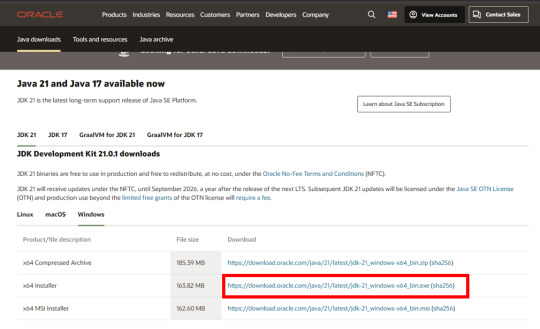
Giao diện tải JDK từ trang Oracle
3. Viết Chương Trình Java Đầu Tiên
Sau khi chuẩn bị môi trường, bạn đã sẵn sàng để viết chương trình Java đầu tiên. Chúng ta sẽ tạo một chương trình đơn giản in ra dòng chữ "Hello, World!".
Bước 1: Tạo File Java
Mở Notepad hoặc IDE bạn đã cài.
Viết đoạn mã sau:
public class HelloWorld { public static void main(String[] args) { System.out.println("Hello, World!"); }}
Lưu file với tên HelloWorld.java (tên file phải trùng với tên class và có đuôi .java).
Giải thích mã:
public class HelloWorld: Khai báo một lớp tên HelloWorld.
public static void main: Hàm chính, điểm bắt đầu của chương trình.
System.out.println: In dòng chữ "Hello, World!" ra màn hình.
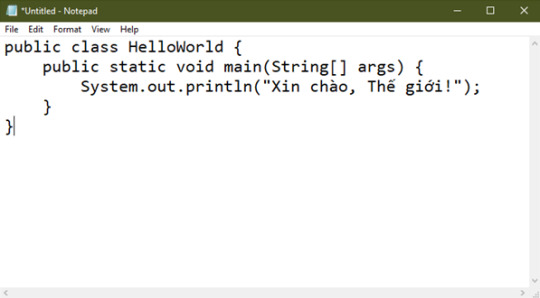
Đoạn mã trong notepad
Bước 2: Biên Dịch Chương Trình
Mở Command Prompt (nhấn Win + R, gõ cmd).
Điều hướng đến thư mục chứa file HelloWorld.java bằng lệnh cd (ví dụ: cd C:\Users\YourName\Documents).
Biên dịch mã bằng lệnh:javac HelloWorld.java Lệnh này tạo file HelloWorld.class.
Bước 3: Chạy Chương Trình
Trong Command Prompt, gõ:java HelloWorld
Kết quả: Màn hình hiển thị dòng chữ Hello, World!.
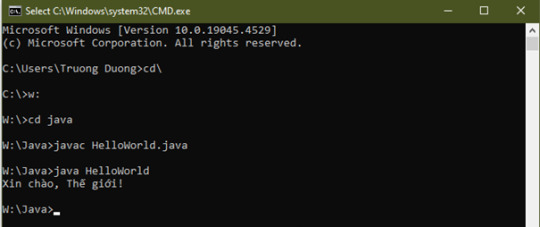
Các dòng lệnh để chạy chương trình java trong Command Prompt
4. Một Số Lỗi Thường Gặp Khi Viết Chương Trình Java Đầu Tiên
Người mới bắt đầu thường gặp một số lỗi cơ bản. Dưới đây là cách khắc phục:
Lỗi "javac is not recognized": Kiểm tra lại biến môi trường PATH đã được thiết lập đúng chưa.
Lỗi tên file không khớp: Đảm bảo tên file và tên class giống nhau (ví dụ: HelloWorld.java cho class HelloWorld).
Lỗi cú pháp: Kiểm tra kỹ dấu ngoặc, dấu chấm phẩy trong mã.
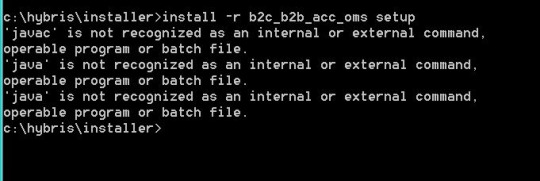
Lỗi "javac is not recognized"
5. Mẹo Để Học Java Hiệu Quả Trên Windows
Thực hành thường xuyên: Viết các chương trình nhỏ như máy tính đơn giản, in bảng cửu chương.
Sử dụng IDE: Chuyển sang IntelliJ IDEA hoặc Eclipse khi bạn quen với cú pháp để tăng hiệu suất.
Tham gia cộng đồng: Các diễn đàn như Stack Overflow, Reddit có nhiều tài liệu và câu trả lời hữu ích.
Học qua video: Xem các hướng dẫn trên YouTube để hình dung rõ hơn cách thiết lập và lập trình.
6. Kết Luận
Viết chương trình Java đầu tiên trên Windows là một bước khởi đầu thú vị trong hành trình học lập trình. Với các bước cài đặt JDK, thiết lập môi trường, và viết mã đơn giản như "Hello, World!", bạn đã đặt nền tảng vững chắc để khám phá thêm về Java. Hãy kiên trì thực hành và tìm hiểu các thư viện, framework như Spring hoặc JavaFX để phát triển kỹ năng.

Hy vọng bài viết này giúp bạn dễ dàng bắt đầu với Java trên Windows! Nếu bạn có câu hỏi, hãy để lại bình luận để được hỗ trợ.
💡 Hướng Dẫn Viết Chương Trình Java Đầu Tiên Trên Windows
Bắt đầu hành trình lập trình với Java! Hướng dẫn từng bước cách cài đặt JDK, viết code đơn giản và chạy chương trình Java đầu tiên bằng Command Prompt.
🌍 Website: Java Highlight
#JavaHighlight#JavaCoBan#JavaChoNguoiMoiBatDau#JavaFirstProgram#JDK#JavaTutorial#LapTrinhJava#JavaDevelopment#HelloWorldJava#JavaWindows#CodeJava#JavaTips
0 notes
Text
Exploring the Exciting Java 21 New Features
Introduction: Java 21 has landed, bringing along a treasure trove of new features and enhancements designed to streamline development workflows and empower Java programmers worldwide. In this comprehensive blog post, we’ll explore each of the exciting new features introduced in Java 21, accompanied by code examples to illustrate their practical applications. Let’s embark on a journey through the…
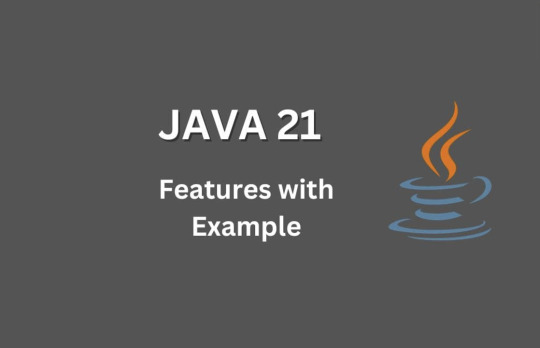
View On WordPress
1 note
·
View note
Text
The History of Java Programming: From Its Humble Beginnings to Dominance in Software Development
Java is one of the most influential programming languages in the modern era, known for its versatility, portability, and robustness. Developed in the early 1990s, it has left a lasting impact on the software industry, helping build countless applications, from mobile games to enterprise-level software. In this blog, we'll explore Java’s fascinating history, its motivations, its growth, and its influence on today’s technology landscape.
The Genesis of Java
Java originated in the early 1990s as part of a project at Sun Microsystems. The project, initially called the "Green Project," was led by James Gosling, alongside Mike Sheridan and Patrick Naughton. The team's goal was to develop a language for embedded systems, specifically for appliances like televisions, which were beginning to incorporate smart technology.
The language was initially called "Oak," named after an oak tree outside Gosling's office. However, due to a trademark conflict, it was eventually renamed Java. The name "Java" was inspired by a type of coffee popular with the developers, signifying their relentless energy and drive.
Motivation Behind Java's Creation
Java was developed to address several key challenges in software development at the time:
Portability: Most languages of the day, such as C and C++, were platform-dependent. This meant that software needed significant modification to run on different operating systems. Gosling and his team envisioned a language that could be executed anywhere without alteration. This led to the now-famous slogan, "Write Once, Run Anywhere" (WORA).
Reliability: C and C++ were powerful, but they had pitfalls like manual memory management and complex pointers, which often led to errors. Java aimed to eliminate these issues by offering features like automatic memory management through garbage collection.
Internet Revolution: As the internet began to take shape, Java was positioned to take advantage of this growing technology. Java’s platform independence and security made it an ideal choice for internet-based applications.
The Birth of Java (1995)
The Green Project initially produced a device called Star7, an interactive television set-top box. While innovative, it didn't achieve widespread success. However, by the mid-1990s, the internet was gaining traction, and Sun Microsystems realized Java’s true potential as a programming language for web applications.
In 1995, Java was officially launched with the release of the Java Development Kit (JDK) 1.0. At the same time, Netscape Navigator, a popular web browser, announced that it would support Java applets. This gave Java immense exposure and set the stage for its rapid adoption in the software development community.
Key Features that Set Java Apart
From the beginning, Java had several features that distinguished it from its contemporaries:
Platform Independence: Java programs are compiled into an intermediate form called bytecode, which runs on the Java Virtual Machine (JVM). The JVM acts as a mediator between the bytecode and the underlying system, allowing Java programs to be executed on any platform without modification.
Object-Oriented: Java was designed from the ground up as an object-oriented language, emphasizing modularity, reusability, and scalability. This feature made Java particularly attractive for building complex and large-scale applications.
Automatic Memory Management: Java's garbage collector automatically handles memory deallocation, reducing the risk of memory leaks and other errors that plagued languages like C and C++.
Security: Java was designed with a focus on security, particularly given its intended use for internet applications. The JVM serves as a secure sandbox, and Java’s bytecode verification process ensures that malicious code cannot be executed.
Evolution of Java Versions
Since its release in 1995, Java has undergone several iterations, each bringing new features and improvements to enhance the developer experience and address the evolving needs of software applications.
Java 1.0 (1996): The first version of Java was mainly used for applets on web browsers. It came with basic tools, libraries, and APIs, establishing Java as a mainstream programming language.
Java 2 (1998): With the release of J2SE (Java 2 Platform, Standard Edition), Java evolved from a simple web language to a complete, general-purpose development platform. Java 2 introduced the Swing library, which provided advanced tools for building graphical user interfaces (GUIs). This release also marked the beginning of Java Enterprise Edition (J2EE), which extended Java for server-side applications.
Java 5 (2004): Java 5, initially called Java 1.5, was a significant update. It introduced Generics, Annotations, Enumerations, and Autoboxing/Unboxing. The updated version also brought improved syntax and functionality, which simplified writing and reading code.
Java SE 7 (2011) and Java SE 8 (2014): Java SE 7 brought features like try-with-resources, simplifying exception handling. Java SE 8 was a transformative release, introducing Lambda expressions and Stream APIs. This version brought functional programming aspects to Java, allowing developers to write more concise and expressive code.
Java 9 to Java 17 (2017-2021): Java 9 introduced the module system to help organize large applications. Java 11 and later versions moved towards a more rapid release cadence, with new features appearing every six months. Java 17, released in 2021, became a long-term support (LTS) version, offering several advancements like improved garbage collection, pattern matching, and record classes.
The Java Community and OpenJDK
Java's development has always been characterized by a strong community influence. Initially controlled by Sun Microsystems, Java's fate changed when Oracle Corporation acquired Sun in 2010. After the acquisition, Oracle made significant strides towards making Java more open and community-driven.
OpenJDK, an open-source implementation of Java, became the reference implementation starting from Java 7. This move encouraged greater collaboration, transparency, and diversity within the Java ecosystem. OpenJDK allowed more organizations to contribute to Java’s development and ensure its continued growth.
Java in the Enterprise and Beyond
Java has become synonymous with enterprise-level software development, thanks in part to the introduction of Java EE (now known as Jakarta EE). Java EE provides a set of specifications and tools for building large-scale, distributed, and highly reliable applications. The Java ecosystem, including frameworks like Spring, Hibernate, and Apache Struts, has contributed to its popularity in enterprise environments.
Java also became a key player in the development of Android applications. Android Studio, Google's official IDE for Android development, is powered by Java, which contributed significantly to its widespread adoption. Although Kotlin, another JVM language, is now gaining popularity, Java remains a core language for Android.
The Challenges Java Faced
Despite its success, Java faced competition and challenges over the years. Languages like C#, developed by Microsoft, and Python have gained traction due to their developer-friendly features. Java has been criticized for its verbosity compared to more modern languages. However, the Java community’s active contributions and Oracle’s improvements, including adding modern programming paradigms, have kept it relevant.
Another significant challenge was the rise of JavaScript for web development. While Java was initially popular for web applets, JavaScript became the dominant language for front-end development. Java's relevance in web applications decreased, but it found its niche in server-side applications, enterprise systems, and Android.
Java Today and Its Future
Today, Java is one of the most popular programming languages globally, powering applications across various sectors, including finance, healthcare, telecommunications, and education. Java’s strength lies in its mature ecosystem, robust performance, and scalability.
The new six-month release cycle initiated by Oracle has brought excitement back into the Java world, with new features being added frequently, keeping the language modern and in line with developer needs. Java 17, as an LTS version, is a stable platform for enterprises looking for reliable updates and support over the long term.
Looking forward, Java’s evolution focuses on improving developer productivity, adding more concise language features, and optimizing performance. Java's adaptability and continuous evolution ensure its place as a leading language for both new projects and legacy systems.
Conclusion
Java’s journey from a language for set-top boxes to becoming a foundational tool in enterprise computing, Android applications, and beyond is nothing short of remarkable. Its creation was driven by a need for portability, reliability, and ease of use. Over nearly three decades, Java has evolved to remain relevant, keeping pace with technological advancements while preserving its core values of reliability and platform independence.
The language’s robust community, open-source development model, and wide adoption in critical applications guarantee that Java will remain a force in software development for many years to come. It has not only withstood the test of time but continues to thrive in a constantly changing technology landscape—an enduring testament to the vision of its creators and the collective effort of its global community.
2 notes
·
View notes
Text
From Novice to Java Pro: A Step-by-Step Learning Journey
Java programming, renowned for its platform independence and versatility, is a sought-after language in the world of software development. It's the language behind countless web applications, mobile apps, game development, and more. This blog serves as your comprehensive guide to embarking on a journey to learn and master Java programming. We'll walk you through the basics of programming, Java's syntax and structure, the essential tools and libraries, and the importance of practice.

The Path to Java Proficiency:
1. Understand the Basics of Programming:
Prior Experience: If you're new to programming, it's crucial to start with the foundational concepts. Variables, data types, control structures (if-else, loops), and functions are universal principles that you need to understand before delving into any programming language, including Java.
What to Learn: Begin by grasping the basics of programming logic and problem-solving. Familiarize yourself with concepts like variables (to store data), data types (to specify the kind of data), and control structures (to make decisions and loop through actions). These concepts serve as the building blocks for Java programming.
2. Java Syntax and Structure:
Prior Experience: As you delve into Java, you'll find that it's an object-oriented language with its unique syntax and structure. While prior programming experience is beneficial, it's not a prerequisite. You can start with Java as your first language.
What to Learn: Java introduces you to classes and objects. Classes are blueprints for creating objects, which are instances of classes. Java is known for its object-oriented nature, where you'll encounter concepts like inheritance (creating new classes based on existing ones), polymorphism (objects of different classes can be treated as objects of the same class), encapsulation (data hiding), and abstraction (simplifying complex reality by modeling classes based on real-world objects).
3. Get Your Hands on a Compiler and IDE:
Prior Experience: No prior experience is required to set up your Java development environment.
What to Learn: To start writing and running Java code, you'll need to install a Java Development Kit (JDK), which includes the Java compiler (javac). This kit allows you to compile your source code into bytecode that the Java Virtual Machine (JVM) can execute. Additionally, install an Integrated Development Environment (IDE) like Eclipse, IntelliJ IDEA, or NetBeans. These IDEs provide a user-friendly interface for coding, debugging, and managing your Java projects.
4. Learn the Java Standard Library:
Prior Experience: No specific prior experience is necessary, but familiarity with basic programming concepts is beneficial.
What to Learn: Java's power lies in its extensive standard library. This library includes pre-built classes and packages that simplify common programming tasks. For example, you can utilize classes in the java.io package to handle file input and output. You'll explore the java.lang package, which provides fundamental classes like String and Integer. Understanding this library is crucial for performing operations like file handling, string manipulation, and working with data structures.
5. Practice, Practice, Practice:
Prior Experience: No prior experience is required. This stage is suitable for beginners and those with basic programming knowledge.
What to Learn: The key to mastering Java or any programming language is practice. Apply the knowledge you've gained by working on small coding projects. Start with simple programs and gradually move on to more complex tasks. Solving programming challenges, such as those on websites like LeetCode or HackerRank, is an excellent way to put your skills to the test. Build simple applications to get hands-on experience in real-world scenarios.
6. Join Java Communities:
Prior Experience: No prior experience is needed to join Java communities.
What to Learn: Engage with Java communities and forums, such as Stack Overflow or Reddit's r/java. These platforms provide a space to ask questions, seek advice, and learn from experienced Java developers. You can also contribute by answering questions and sharing your knowledge.
7. Enroll in Java Courses:
Prior Experience: Enrolling in Java courses is suitable for learners of all levels, from beginners to advanced users.
What to Learn: ACTE Technologies offers comprehensive Java training programs that cater to a diverse range of learners. These programs are designed to provide hands-on experience and real-world examples, ensuring that you gain practical skills in Java programming.

In your journey to master Java programming, structured training plays a pivotal role. ACTE Technologies is a trusted partner, offering Java training programs for learners at all levels. Whether you're a beginner taking your first steps in Java or an experienced programmer seeking to expand your skill set, they can provide the guidance and resources needed to excel in the world of Java development. Consider exploring their Java courses to kickstart or enhance your Java programming journey. Java programming is a versatile and essential language, and mastering it is a rewarding journey. With dedication, practice, and structured training, you can become a proficient Java developer. Institutions like ACTE Technologies offer valuable resources and courses to accelerate your learning process, making your journey to Java mastery even more efficient.
7 notes
·
View notes
Text
CSE 391 Assignment 2: More Unix Shell
This assignment continues to practice using the bash shell and basics of combining commands using redirection and pipes. For Task 0 there is nothing to submit. For Tasks 1 and 2 you will submit your responses to Gradescope. Some parts of this assignment depend on compiling and running Java programs from the command line. Many distributions of Linux do not include Sun’s Java Development Kit (JDK).…
0 notes
Text
Understanding Java Licensing Costs: Is Java Free?
Java has been one of the most popular programming languages for decades, used in everything from enterprise applications to mobile development. However, recent changes in Oracle’s licensing policies have sparked widespread discussions about Java licensing costs. Many businesses and developers are now asking: Is Java free? The answer to this question depends on how Java is used and which version is being implemented. In this article, we will break down Java’s licensing costs, clarify the different versions available, and help businesses and developers understand what is free and what is not.
The Evolution of Java Licensing
For years, Java was freely available under the Sun Microsystems’ leadership and continued to be free after Oracle acquired Sun in 2010. However, in 2019, Oracle introduced a new subscription-based licensing model for its Java SE (Standard Edition), creating confusion and uncertainty in the developer community.
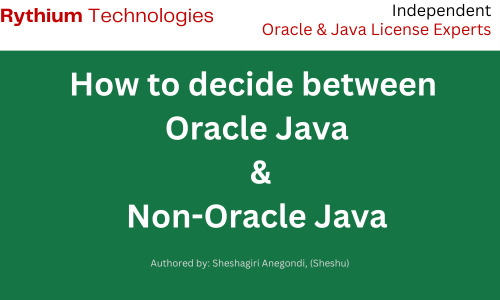
Previously, businesses could use Oracle’s Java without worrying about licensing fees. But under the new model, users who need commercial support and updates must pay a subscription fee. This shift has led many to explore alternative versions of Java that remain free.
Is Java Free? Understanding the Different Versions
To answer the question Is Java free?, it’s essential to distinguish between the different distributions available. Java exists in multiple forms, and each comes with different licensing implications.
1. Oracle JDK (Java Development Kit)
Oracle JDK was historically the go-to version for enterprise users, but since 2019, Oracle has changed its licensing terms. Now, commercial use of Oracle JDK requires a subscription. If businesses continue using Oracle JDK without a valid license, they risk violating Oracle’s terms and potentially facing legal or financial consequences.
2. OpenJDK (Open Java Development Kit)
OpenJDK is an open-source implementation of Java and remains free to use under the GNU General Public License (GPL) with Classpath Exception. Many companies have switched to OpenJDK to avoid paying Java licensing costs. However, OpenJDK does not offer long-term support (LTS) from Oracle, meaning users must rely on community support or choose distributions backed by other vendors.
3. Other Java Distributions
Several organizations provide their own distributions of OpenJDK with long-term support and additional features. These include:
Adoptium (Eclipse Temurin): A popular, free OpenJDK build with community support.
Amazon Corretto: Amazon’s free distribution of OpenJDK with long-term support.
Red Hat OpenJDK: A Red Hat-supported OpenJDK distribution, often used in enterprise environments.
Azul Zulu: A commercial Java distribution with both free and paid options.
IBM Semeru: IBM’s OpenJDK variant with enterprise support.
Choosing the right Java version depends on an organization’s specific needs, whether it requires enterprise support, security patches, or simply a free Java runtime for development.
Breaking Down Java Licensing Costs
Oracle’s Java licensing costs are based on a subscription model, and the pricing varies depending on the number of users and computing power. Below is a basic outline of the cost structure:
Per-User Pricing: Oracle charges a fee per named user, commonly applied in desktop environments.
Per-Processor Pricing: For server environments, Oracle licenses Java based on the number of processors in use.
Enterprise Pricing Plans: Large organizations may negotiate customized pricing with Oracle.
For small businesses and individual developers, these costs can quickly add up. This is why many have shifted to OpenJDK or other free distributions to avoid licensing fees.
How to Avoid Java Licensing Costs
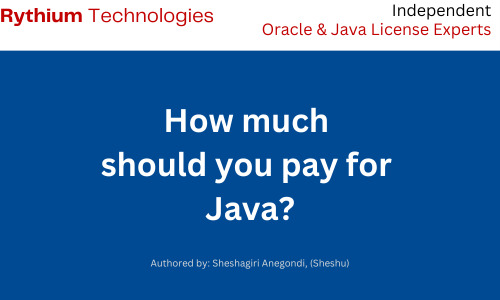
Since Java licensing costs can be substantial, businesses and developers should consider the following strategies to minimize expenses:
Switch to OpenJDK or Alternative Distributions Many organizations have already moved away from Oracle JDK to OpenJDK-based distributions. OpenJDK is functionally equivalent to Oracle JDK but is free to use.
Use Oracle JDK Only for Development Oracle allows free use of Java SE for development, testing, and personal use. However, deploying Oracle JDK in a production environment without a license can lead to fees.
Monitor Java Usage Organizations should conduct an internal audit to understand their Java usage and determine whether they need a paid license or can transition to a free alternative.
Consider Vendor-Supported OpenJDK Versions If enterprise support is necessary, companies can choose vendor-backed OpenJDK versions like Amazon Corretto, Red Hat OpenJDK, or Azul Zulu.
The Future of Java Licensing
As Oracle continues to refine its licensing policies, businesses and developers must stay informed about changes to Java licensing costs. OpenJDK and other free distributions are becoming increasingly popular, ensuring Java remains accessible to all.
For those wondering, Is Java free?, the answer is yes—but with some caveats. Developers and businesses must carefully assess their needs and choose the right Java distribution to balance cost, support, and long-term sustainability.
Conclusion
Java remains a critical technology in modern software development, but its licensing costs have created new challenges for businesses. Understanding Java licensing costs and answering the question Is Java free? requires careful evaluation of the different distributions available. By exploring alternatives like OpenJDK and vendor-supported versions, organizations can continue using Java while avoiding unnecessary expenses. Whether you are a developer, IT manager, or business owner, staying informed about Java licensing will help you make the best decision for your needs.
0 notes